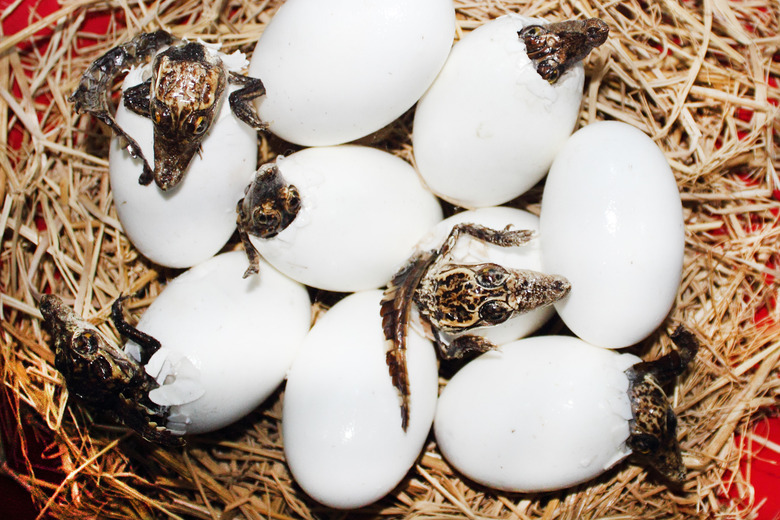The Theory Of Biogenesis
Biogenesis is any process by which lifeforms produce other lifeforms. For example, a spider lays eggs that become other spiders. This premise historically contrasted with the ancient belief in spontaneous generation, which held that certain inorganic substances, left alone, give rise to life (such as bacteria, mice and maggots) in a matter of days. The premise of biogenesis had been suspected long before being definitively demonstrated. A demonstrative experiment, which showed biogenesis right down to the bacterial level, was devised by Louis Pasteur in 1859.
Belief in Spontaneous Generation
Belief in Spontaneous Generation
Spontaneous generation is also known as Aristotelian abiogenesis, after its ancient Greek proponent. The stealth and invisibility of such organisms as flies, mice and bacteria allowed belief in spontaneous generation to hold sway for millennia. Pioneering use of the still-new microscope in the 18th century began to erode its credibility; seeing fly eggs and bacteria under the microscope helped to demystify their nature. By Pasteur's time, experimentation had defended biogenesis at the macroscopic level. Only microscopic biogenesis was left to be proven.
Macroscopic Spontaneous Generation
Macroscopic Spontaneous Generation
In 1668, Francesco Redi addressed the question of macroscopic spontaneous generation when he published the results of an experiment in which he placed rotting meat in a container and covered the container's opening with gauze. If the gauze was absent, maggots would grow on the meat. If the gauze was present, maggots would not grow on the meat, but would appear on the gauze. Redi was observing flies depositing eggs as close to a food source as could be reached.
Microscopic Spontaneous Generation
Microscopic Spontaneous Generation
A century later, an experiment performed by Lazzaro Spallanzani in 1768 indicated biogenesis on the microscopic level. Spallanzani wanted to avoid contamination by boiling a meat broth in a sealed container. The problem with this approach was that air in the container could shatter the container upon heating. Therefore, he evacuated the container after sealing it closed. The broth did not subsequently cloud with bacterial growth, supporting the theory of biogenesis.
Critics charged that air is needed for life. The lack of bacterial growth therefore was presumed due to a lack of air, not because bacteria spread through contamination. This criticism stood for almost a century before Pasteur entered the scene and overturned it.
Pasteur's Experimental Equipment
Pasteur's Experimental Equipment
The 1859 experiment performed by Pasteur unequivocally overturned the theory of spontaneous generation at the microscopic level. He boiled a meat broth in a flask that had a long neck that curved downward, then upward, like a goose neck. The bend in the neck prevented contaminating particles from reaching the broth, while still allowing the free diffusion of air. The fact that the flask allowed for the passage of air was a design breakthrough that finally addressed the critics of Spallanzani.
Pasteur's flask remained free of bacterial growth for as long as the flask remained upright. To show where the contaminating elements were located, he tipped the flask enough for the broth to sweep out the bend in the goose neck; the broth would then quickly become clouded with bacterial growth.
A Common Misconception
A Common Misconception
Some creationists have argued that the law of biogenesis undermines evolutionary theory and the theory that all life originated from inorganic material billions of years ago. However, biogenesis simply invalidates the theory of spontaneous generation–it speaks to what can be accomplished in generational time spans, not over the course of thousands of generations or millions of years.
Theories about the origin of life take into account the lack of predators and the very different chemical makeup of the Earth's atmosphere at the time. They also consider what can be accomplished in millions of years through trial and error. Neither of these is considered in the law of biogenesis. The theory of spontaneous generation speaks of complex life appearing fully formed in days, which theories of the origin of life postulate took millions of years of trial and error to form in conditions that no longer exist on Earth.
Cite This Article
MLA
Dohrman, Paul. "The Theory Of Biogenesis" sciencing.com, https://www.sciencing.com/theory-biogenesis-5419233/. 24 April 2018.
APA
Dohrman, Paul. (2018, April 24). The Theory Of Biogenesis. sciencing.com. Retrieved from https://www.sciencing.com/theory-biogenesis-5419233/
Chicago
Dohrman, Paul. The Theory Of Biogenesis last modified August 30, 2022. https://www.sciencing.com/theory-biogenesis-5419233/
